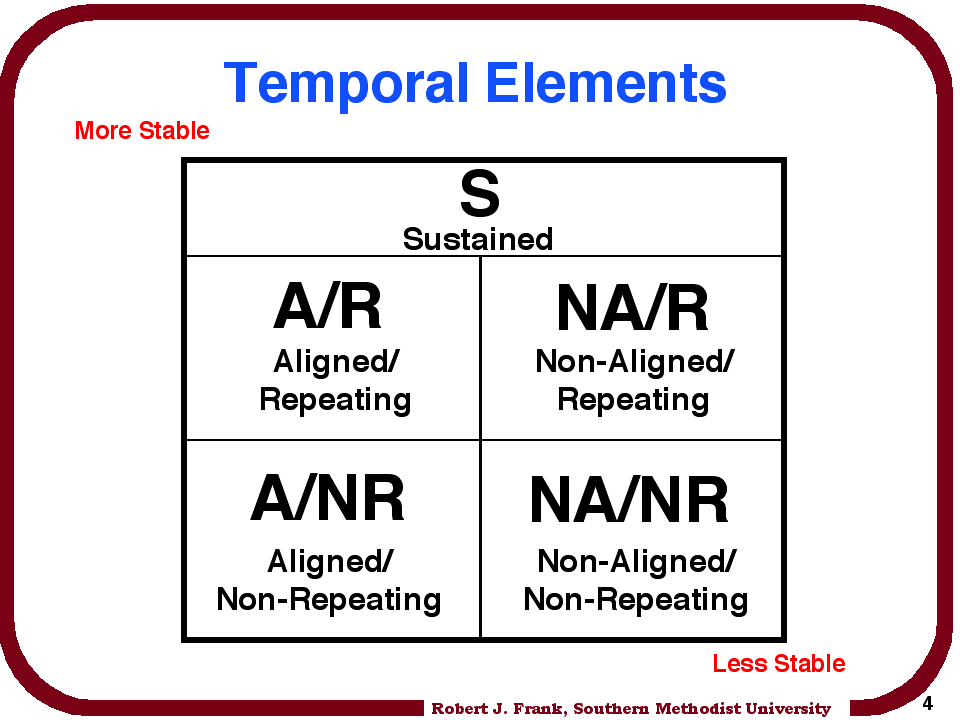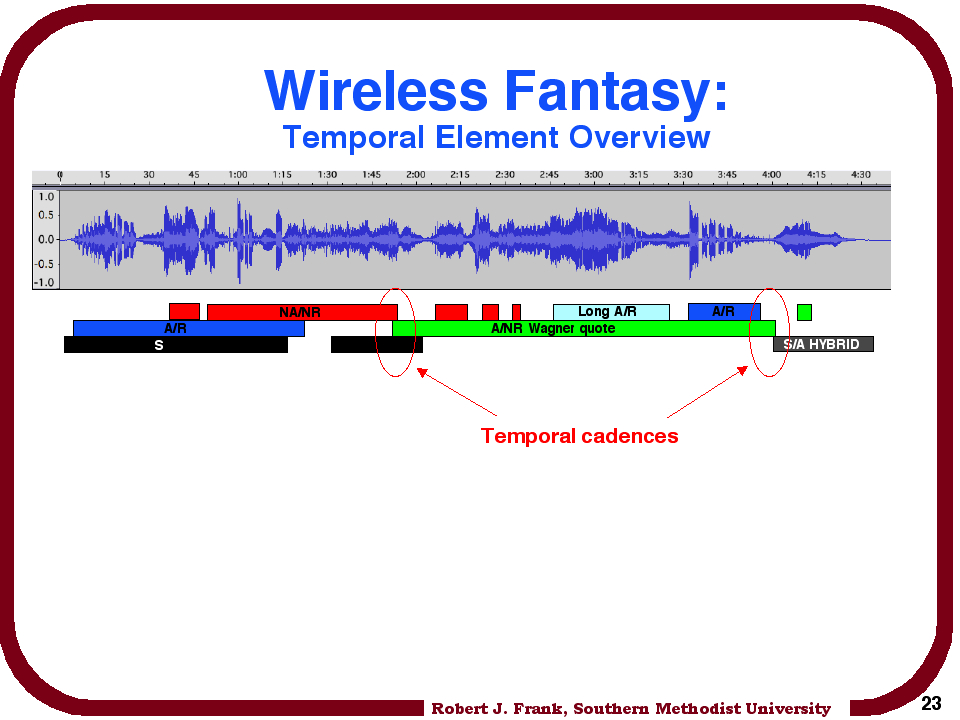Temporal Elements in Music
Welcome
to the informational site. I first began to develop the concept
of musical analysis of temporal elements in my dissertation in 1995,
and over subsequent years have shared this approach in paper
presentations at the Society of Composers, Inc. National Conference
(1996), International Computer Music Conference (2000), Society for
Electro-Acoustic Music in the United States national Conferences (2000,
2008), and the Electroacoustic Music Studies International Conference
(2008). A complete thorough coverage of this approach to hearing,
analyzing, and composing will be covered in my upcoming book "Temporal
Elements in Music" but due to great interest at the above listed
conferences, I have put together this web site to share previous papers
and presentations.

BRIEF INTRODUCTION

RESOURCES

BRIEF INTRODUCTION
Music is a
temporal art form, and although sometimes notated, it only exists in
the form of vibrating air over a span of time. It is a universal
language and a basic human need, with every recorded civilization
having some form of musical expression. Across all barriers of
time and culture, music has the unique ability to speak to our minds
and souls. Understanding how music accomplishes this and how each
dialect of musical expression is put together is essential to better
appreciating and relating to that universal message and the artistic
need it fulfills.
The vast majority of musical analysis has focused on pitch and how that element is structured within each work. However, outside of historical European-based western art music, including contemporary western concert works, electro-acoustic music, indigenous music of Asia and Africa, and the emerging "Sound Art" field, much of the music does not focus upon – or even contain – pitch content at all. Yet, these sonic art forms also appeal to and speak to people on the same level. As a social melting pot, America has also become an artistic melting pot, and these many forms and dialects of musical expression are found all around us. The field of music cognition has made great strides in better understanding how sound effects our brains and in providing a scientific foundation for how we understand and appreciate aural events. However, its application stops there and the synthesis of this information into how we sense, feel, and perceive larger elements in music – structure, flow, cadence, repose, forward motion, climax, and the like – has remained virtually unexplored. This led me to the research that resulted in my doctoral dissertation , which created a system of musical analysis of temporal elements in music. Most existing rhythmic theories and analytical systems apply only to common practice, notated, metered music. For example, at the end of The Stratification of Musical Rhythm Maury Yeston adds the disclaimer that his theories are "... limited to a kind of tonal music in which the middleground rhythmic levels exhibit some regularity of motion." Other texts, like Jonathan Kramer's The Time of Music, thoroughly cover the philosophical unfolding of time within a work and the effects of tonality and pitch material on the perception of time in a work. Like Yeston, however, Kramer remains almost exclusively within the realm of metered, traditional Western music, providing only a passing mention of non-metered works and completely excludes electro acoustic music, musique concrète, and much of the music of other cultures.
This method of analysis of temporal elements focuses not upon pitch, style, technique, or medium, but rather the cognitive relationships between aural events within a work that form the properties of foreground, background, cadence, and the elusive properties of pacing and 'flow' in a work. Originally based upon principles in Jay Dowling's Music Cognition (Dowling, 1986) and now refined by present-day ERP research studies,this approach to understanding music is founded upon fundamental principles of the mind's reaction to the effects of new aural events, sustaining sound, repetition, and alignment to a common pulse. Temporal Element analysis classifies longer, continuing events(beyond 300 ms c.a.) into five general categories: sustained, repeating/aligned, non-repeating/aligned, repeating/non-aligned, and non-repeating/non-aligned. Hybrid elements comprised of traits of two or more categories and transformational processes may be formed and identified, then discussed in terms of their relative level of stability/instability. Once defined and recognized, first-level musical analysis can be accomplished by labeling and summarizing the use of these temporal elements in a work through aural and visual measurements (by ear, through a notated score, or via simple, free sound editing software such as Audacity). Analytical results may then be discussed and presented in a simple, graphic format rather than long sets of complex tables and numeric formulas. Often, elegant structural traits are found in many works that elude current analytical techniques.
The vast majority of musical analysis has focused on pitch and how that element is structured within each work. However, outside of historical European-based western art music, including contemporary western concert works, electro-acoustic music, indigenous music of Asia and Africa, and the emerging "Sound Art" field, much of the music does not focus upon – or even contain – pitch content at all. Yet, these sonic art forms also appeal to and speak to people on the same level. As a social melting pot, America has also become an artistic melting pot, and these many forms and dialects of musical expression are found all around us. The field of music cognition has made great strides in better understanding how sound effects our brains and in providing a scientific foundation for how we understand and appreciate aural events. However, its application stops there and the synthesis of this information into how we sense, feel, and perceive larger elements in music – structure, flow, cadence, repose, forward motion, climax, and the like – has remained virtually unexplored. This led me to the research that resulted in my doctoral dissertation , which created a system of musical analysis of temporal elements in music. Most existing rhythmic theories and analytical systems apply only to common practice, notated, metered music. For example, at the end of The Stratification of Musical Rhythm Maury Yeston adds the disclaimer that his theories are "... limited to a kind of tonal music in which the middleground rhythmic levels exhibit some regularity of motion." Other texts, like Jonathan Kramer's The Time of Music, thoroughly cover the philosophical unfolding of time within a work and the effects of tonality and pitch material on the perception of time in a work. Like Yeston, however, Kramer remains almost exclusively within the realm of metered, traditional Western music, providing only a passing mention of non-metered works and completely excludes electro acoustic music, musique concrète, and much of the music of other cultures.
This method of analysis of temporal elements focuses not upon pitch, style, technique, or medium, but rather the cognitive relationships between aural events within a work that form the properties of foreground, background, cadence, and the elusive properties of pacing and 'flow' in a work. Originally based upon principles in Jay Dowling's Music Cognition (Dowling, 1986) and now refined by present-day ERP research studies,this approach to understanding music is founded upon fundamental principles of the mind's reaction to the effects of new aural events, sustaining sound, repetition, and alignment to a common pulse. Temporal Element analysis classifies longer, continuing events(beyond 300 ms c.a.) into five general categories: sustained, repeating/aligned, non-repeating/aligned, repeating/non-aligned, and non-repeating/non-aligned. Hybrid elements comprised of traits of two or more categories and transformational processes may be formed and identified, then discussed in terms of their relative level of stability/instability. Once defined and recognized, first-level musical analysis can be accomplished by labeling and summarizing the use of these temporal elements in a work through aural and visual measurements (by ear, through a notated score, or via simple, free sound editing software such as Audacity). Analytical results may then be discussed and presented in a simple, graphic format rather than long sets of complex tables and numeric formulas. Often, elegant structural traits are found in many works that elude current analytical techniques.

RESOURCES
This paper
presents in a concise form the foundations this system. Although
applied to electro-acoustic music, the basic principles are
equally applicable to acoustic works. This paper was presented at
ICMC 200-Berlin and SEAMUS 2000 (Published in Journal SEAMUS)
This paper
presents a brief recap of the structure of Temporal Elelments in relationship to Pierre Schaeffer's 'sound objects', and analyzes cadence structure in works by Takemitsu, Ussachevsky,and Schaeffer. (Published in Proceedings from the 2008 Electroacoacoustic Music Studies Network International Conference, 3-7 juin 2008 (Paris) - INA-GRM et Université Paris-Sorbonne (MINT-OMF))
This series of videos presents
in audio+video format an Introduction to Temporal Elements, and two examples of temporal analyses of Electro-Acoustic works. This series will
begin with works analyzed and presented at SEAMUS, ICMC, and EMS
conferences, and add new works as they become available. If you
wish to obtain a larger/higher resolution version of educational
purposes, please contact the author at: robfrank@smu.edu.
Catalog of compositions with sound
files, biographical
information, upcoming presentations and performances, Performer
Adaptive Score software, and other
information may be found on this web site. Please use this URL
when refering others to this site.
All
materials on this web site are copyright 2008 © Robert J.
Frank. All rights reserved.

